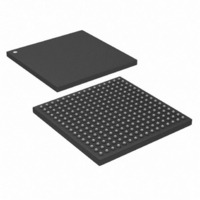DS26518GN+ Maxim Integrated Products, DS26518GN+ Datasheet - Page 62

DS26518GN+
Manufacturer Part Number
DS26518GN+
Description
IC TXRX T1/E1/J1 8PORT 256-CSBGA
Manufacturer
Maxim Integrated Products
Type
Transceiverr
Specifications of DS26518GN+
Number Of Drivers/receivers
8/8
Protocol
T1/E1/J1
Voltage - Supply
3.135 V ~ 3.465 V
Mounting Type
Surface Mount
Package / Case
256-CSBGA
Lead Free Status / RoHS Status
Lead free / RoHS Compliant
- Current page: 62 of 312
- Download datasheet (3Mb)
9.9.6.1 Additional E1 Receive Sa- and Si-Bit Receive Operation (E1 Mode)
The DS26518, when operated in the E1 mode, provides for access to both the Sa and the Si bits via two methods.
The first involves using the internal
an expanded version of the first method.
9.9.6.1.1 Internal Register Scheme Based on Double-Frame (Method 1)
On the receive side, the
locations. The E1RAFand
Align Frame bit in Receive Latched Status Register 2 (RLS2.0) will indicate that the contents of the RAF and RNAF
have been updated. The host can use the RLS2.0 bit to know when to read the
host has 250μs to retrieve the data before it is lost.
9.9.6.1.2 Internal Register Scheme Based on CRC-4 Multiframe (Receive)
On the receive side, there is a set of eight registers (E1RsiAF, E1RSiNAF, E1RRA,
the Si and Sa bits as they are received. These registers are updated with the setting of the receive CRC-4
multiframe bit in Receive Latched Status Register 2 (RLS2.1). The host can use the RLS2.1 bit to know when to
read these registers. The user has 2ms to retrieve the data before it is lost. See the register descriptions for
additional information.
9.9.6.1.3 Internal Register Scheme Based on CRC-4 Multiframe (Transmit)
On the transmit side there is a set of eight registers (E1TSiAF, E1TSiNAF, E1TRA,
the E1 Transmit Sa-Bit Control Register (E1TSACR), can be programmed to insert both Si and Sa data. Data is
sampled from these registers with the setting of the transmit multiframe bit in Transmit Latched Status Register 1
(TLS1.3). The host can use the TLS1.3 bit to know when to update these registers. It has 2ms to update the data or
else the old data will be retransmitted. See the register descriptions in Section
9.9.6.2 Sa-Bit Monitoring and Reporting
In addition to the registers outlined above, the DS26518 provides status and interrupt capability in order to detect
changes in the state of selected Sa bits. The
monitored for a change of state. When a change of state is detected in one of the enabled Sa bit positions, a status
bit is set in the
by unmasking RIM7.0 (SaXCD). If multiple Sa bits have been enabled, the user can read the
address 06Eh to determine the current value of each Sa bit.
For the Sa6 bits, additional support is available to detect specific codewords per ETS 300 233. The Sa6CODE
register will report the received Sa6 codeword. The codeword must be stable for a period of three submultiframes
and be different from the previous stored value in order to be updated in this register. See the
description for further details on the operation of this register and the values reported in it. An additional status bit is
provided in
status bit in
9.9.7 Maintenance and Alarms
The DS26518 provides extensive functions for alarm detection and generation. It also provides diagnostic functions
for monitoring of performance and sending of diagnostic information:
•
•
•
•
•
•
•
Real-time and latched status bits, interrupts and interrupt mask for transmitter and receiver
LOS detection
RIA detection and generation
Error counters
DS0 monitoring
Milliwatt generation and detection
Slip buffer status for transmit and receive
R
3 9
R IM7
9
LS7.1 (Sa6CD) to indicate if the received Sa6 codeword has changed. A mask bit is provided for this
R LS7
9
to allow for interrupt generation when enabled.
register via the SaXCD bit (bit 0). This status bit can in turn be used to generate an interrupt
E1RAF
E1RNAF
and
E1RAF/E1RNAF
E1RNAF
registers are updated on align frame boundaries. The setting of the Receive
registers will always report the data as it received in the Sa and Si bit
E1RSAIMR
62 of 312
and
E1TAF/E1TNAF
register can be used to select which Sa bits are
registers. The second method involves
10
E1RAF
for more information.
E1RSa4
E1TSa4
and
E1RNAF
to E1RSa8) that report
to E1TSa8) that, via
SaBITS
S a6CODE
9
registers. The
register at
register
Related parts for DS26518GN+
Image
Part Number
Description
Manufacturer
Datasheet
Request
R

Part Number:
Description:
8-port T1/e1/j1 Transceiver
Manufacturer:
Maxim Integrated Products, Inc.
Datasheet:

Part Number:
Description:
Ds26518 8-port T1/e1/j1 Transceiver
Manufacturer:
Maxim Integrated Products, Inc.

Part Number:
Description:
power light source LUXEON� Collimator
Manufacturer:
LUMILEDS [Lumileds Lighting Company]
Datasheet:

Part Number:
Description:
MAX7528KCWPMaxim Integrated Products [CMOS Dual 8-Bit Buffered Multiplying DACs]
Manufacturer:
Maxim Integrated Products
Datasheet:

Part Number:
Description:
Single +5V, fully integrated, 1.25Gbps laser diode driver.
Manufacturer:
Maxim Integrated Products
Datasheet:

Part Number:
Description:
Single +5V, fully integrated, 155Mbps laser diode driver.
Manufacturer:
Maxim Integrated Products
Datasheet:

Part Number:
Description:
VRD11/VRD10, K8 Rev F 2/3/4-Phase PWM Controllers with Integrated Dual MOSFET Drivers
Manufacturer:
Maxim Integrated Products
Datasheet:

Part Number:
Description:
Highly Integrated Level 2 SMBus Battery Chargers
Manufacturer:
Maxim Integrated Products
Datasheet:

Part Number:
Description:
Current Monitor and Accumulator with Integrated Sense Resistor; ; Temperature Range: -40°C to +85°C
Manufacturer:
Maxim Integrated Products

Part Number:
Description:
TSSOP 14/A�/RS-485 Transceivers with Integrated 100O/120O Termination Resis
Manufacturer:
Maxim Integrated Products

Part Number:
Description:
TSSOP 14/A�/RS-485 Transceivers with Integrated 100O/120O Termination Resis
Manufacturer:
Maxim Integrated Products

Part Number:
Description:
QFN 16/A�/AC-DC and DC-DC Peak-Current-Mode Converters with Integrated Step
Manufacturer:
Maxim Integrated Products

Part Number:
Description:
TDFN/A/65V, 1A, 600KHZ, SYNCHRONOUS STEP-DOWN REGULATOR WITH INTEGRATED SWI
Manufacturer:
Maxim Integrated Products

Part Number:
Description:
Integrated Temperature Controller f
Manufacturer:
Maxim Integrated Products










